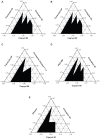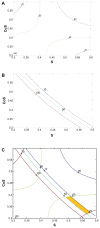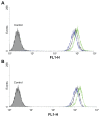A novel folate-modified self-microemulsifying drug delivery system of curcumin for colon targeting
- PMID: 22275831
- PMCID: PMC3263408
- DOI: 10.2147/IJN.S27639
A novel folate-modified self-microemulsifying drug delivery system of curcumin for colon targeting
Abstract
Background: The objective of this study was to prepare, characterize, and evaluate a folate-modified self-microemulsifying drug delivery system (FSMEDDS) with the aim to improve the solubility of curcumin and its delivery to the colon, facilitating endocytosis of FSMEDDS mediated by folate receptors on colon cancer cells.
Methods: Ternary phase diagrams were constructed in order to obtain the most efficient self-emulsification region, and the formulation of curcumin-loaded SMEDDS was optimized by a simplex lattice experiment design. Then, three lipophilic folate derivatives (folate-polyethylene glycol-distearoylphosphatidylethanolamine, folate-polyethylene glycol-cholesteryl hemisuccinate, and folate-polyethylene glycol-cholesterol) used as a surfactant were added to curcumin-loaded SMEDDS formulations. An in situ colon perfusion method in rats was used to optimize the formulation of FSMEDDS. Curcumin-loaded FSMEDDS was then filled into colon-targeted capsules and the in vitro release was investigated. Cytotoxicity studies and cellular uptake studies was used in this research.
Results: The optimal formulation of FSMEDDS obtained with the established in situ colon perfusion method in rats was comprised of 57.5% Cremophor(®) EL, 32.5% Transcutol(®) HP, 10% Capryol™ 90, and a small amount of folate-polyethylene glycol-cholesteryl hemisuccinate (the weight ratio of folate materials to Cremophor EL was 1:100). The in vitro release results indicated that the obtained formulation of curcumin could reach the colon efficiently and release the drug immediately. Cellular uptake studies analyzed with fluorescence microscopy and flow cytometry indicated that the FSMEDDS formulation could efficiently bind with the folate receptors on the surface of positive folate receptors cell lines. In addition, FSMEDDS showed greater cytotoxicity than SMEDDS in the above two cells.
Conclusion: FSMEDDS-filled colon-targeted capsules are a potential carrier for colon delivery of curcumin.
Keywords: SMEDDS; colon targeting; curcumin; folate receptor.
Figures






Similar articles
-
Development and evaluation of self-microemulsifying liquid and pellet formulations of curcumin, and absorption studies in rats.Eur J Pharm Biopharm. 2010 Nov;76(3):475-85. doi: 10.1016/j.ejpb.2010.07.011. Epub 2010 Jul 24. Eur J Pharm Biopharm. 2010. PMID: 20659556
-
Development of a folate-modified curcumin loaded micelle delivery system for cancer targeting.Colloids Surf B Biointerfaces. 2014 Sep 1;121:206-13. doi: 10.1016/j.colsurfb.2014.05.005. Epub 2014 May 13. Colloids Surf B Biointerfaces. 2014. PMID: 24984268
-
Design and evaluation of a self-microemulsifying drug delivery system for apigenin.Drug Dev Ind Pharm. 2013 May;39(5):662-9. doi: 10.3109/03639045.2012.687378. Epub 2012 May 21. Drug Dev Ind Pharm. 2013. PMID: 22607130
-
Role of excipients in successful development of self-emulsifying/microemulsifying drug delivery system (SEDDS/SMEDDS).Drug Dev Ind Pharm. 2013 Jan;39(1):1-19. doi: 10.3109/03639045.2012.660949. Epub 2012 Feb 29. Drug Dev Ind Pharm. 2013. PMID: 22372916 Review.
-
Self-microemulsifying drug delivery system (SMEDDS)--challenges and road ahead.Drug Deliv. 2015;22(6):675-90. doi: 10.3109/10717544.2014.896058. Epub 2014 Mar 27. Drug Deliv. 2015. PMID: 24670091 Review.
Cited by
-
Development and optimization of polymeric self-emulsifying nanocapsules for localized drug delivery: design of experiment approach.ScientificWorldJournal. 2014;2014:516069. doi: 10.1155/2014/516069. Epub 2014 Nov 24. ScientificWorldJournal. 2014. PMID: 25525620 Free PMC article.
-
Folated synperonic-cholesteryl hemisuccinate polymeric micelles for the targeted delivery of docetaxel in melanoma.Biomed Res Int. 2015;2015:746093. doi: 10.1155/2015/746093. Epub 2015 Mar 8. Biomed Res Int. 2015. PMID: 25839040 Free PMC article.
-
Curcumin, Hormesis and the Nervous System.Nutrients. 2019 Oct 10;11(10):2417. doi: 10.3390/nu11102417. Nutrients. 2019. PMID: 31658697 Free PMC article. Review.
-
Oral Delivery of Biologics in Inflammatory Bowel Disease Treatment.Front Bioeng Biotechnol. 2021 Jun 3;9:675194. doi: 10.3389/fbioe.2021.675194. eCollection 2021. Front Bioeng Biotechnol. 2021. PMID: 34150733 Free PMC article. Review.
-
SL2B aptamer and folic acid dual-targeting DNA nanostructures for synergic biological effect with chemotherapy to combat colorectal cancer.Int J Nanomedicine. 2017 Apr 3;12:2657-2672. doi: 10.2147/IJN.S132929. eCollection 2017. Int J Nanomedicine. 2017. PMID: 28435250 Free PMC article.
References
-
- Basile V, Ferrari E, Lazzari S, Belluti S, Pignedoli F, Imbriano C. Curcumin derivatives: molecular basis of their anti-cancer activity. Biochem Pharmacol. 2009;78(10):1305–1315. - PubMed
-
- Goel A, Kunnumakkara AB, Aggarwal BB. Curcumin as “Curecumin”: from kitchen to clinic. Biochem Pharmacol. 2008;75(4):787–809. - PubMed
-
- Johnson JJ, Mukhtar H. Curcumin for chemoprevention of colon cancer. Cancer Lett. 2007;255(2):170–181. - PubMed
-
- Sharma RA, Gescher AJ, Steward WP. Curcumin: the story so far. Eur J Cancer. 2005;41(13):1995–1968. - PubMed
-
- Prajakta D, Ratnesh J, Chandan K, et al. Curcumin loaded pH-sensitive nanoparticles for the treatment of colon cancer. J Biomed Nanotechnol. 2009;5(5):445–455. - PubMed
Publication types
MeSH terms
Substances
LinkOut - more resources
Full Text Sources
Medical
Research Materials
Miscellaneous

